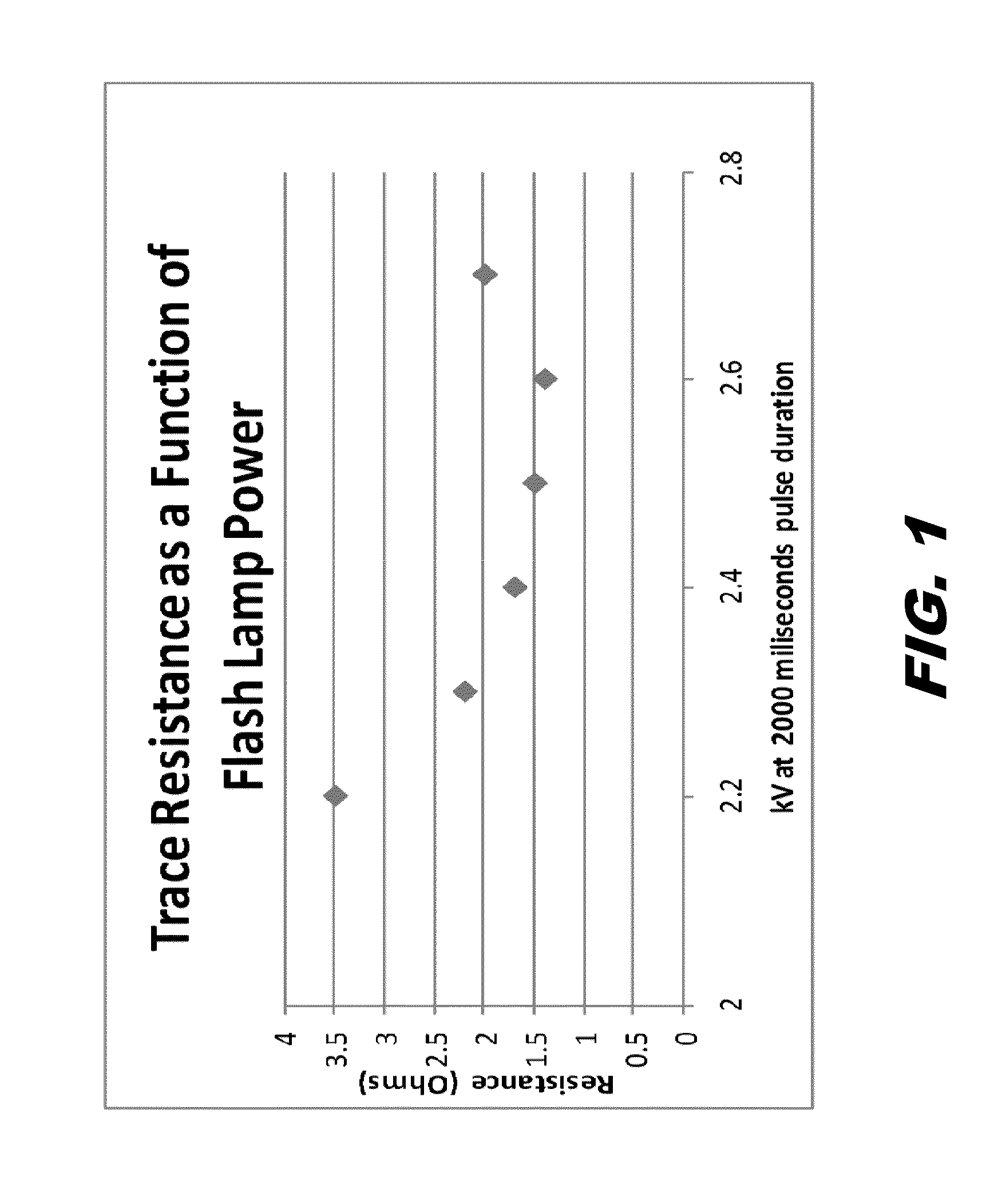Performance of conductive copper paste using copper flake
a technology of conductive copper and flake, applied in the field of materials, can solve the problems of cracking and delamination, heat generated can decompose and vaporize polymers in the applied paste, and achieve the effect of improving the latitude of sintering
- Summary
- Abstract
- Description
- Claims
- Application Information
AI Technical Summary
Benefits of technology
Problems solved by technology
Method used
Image
Examples
example 1
Comparative Paste A
[0042]Into a porcelain bowl was weighed 36.0 g of amorphous copper powder of mean diameter 4.5-7.0 micrometers (Cu CH UF 10 from Ecka Granules GmbH) and 9.0 g of polymer-coated copper nanoparticles of mean diameter 50 nm. To these powders was added 2.5 g of a resin consisting of 1.25 g of 40,00 C0 molecular weight polyvinlypyrrolidone (PVP), 1.0 g of ethylene glycol (EG), and 0.25 g of diacetone alcohol. The mixture was kneaded with a spatula until a thick paste was obtained. This paste was further mixed on a three roll mill until a uniform viscous paste was obtained.
Inventive Paste A
[0043]This paste was prepared as Comparative A above except that 36.0 g of copper flake with a mean diameter of 1.0-5.0 micrometers was used in place of the amorphous copper. One source of suitable copper flake is product CU 101 from Atlantic Equipment Engineers, Bergenfield, N.J.
[0044]The ratio of copper flake to nanoparticle copper is in the range from 2:1 to 5:1 by weight. The mean...
example 2
[0053]Inventive Paste B was prepared in the same way as Comparative A above, except that a flaked copper of mean particle size of 4.0-13 microns was used in place of the amorphous copper.
[0054]Inventive Paste C was similarly prepared to Inventive Paste B except that glycerol was added to the resin in place of a percentage of the other solvents such that the weight percentage of glycerol in the final paste was about 2%.
[0055]Comparative A and Inventive B and C were printed and sintered as above except that they were printed onto DuPont Melinex® 505 polyester film which is a temperature sensitive substrate. The sintering latitudes observed are shown in Table 1.
TABLE 1Sintering Latitudes for Example 2Sintering LatitudePasteMicro Copper Type(Joules)Comparative AAmorphous0Inventive BFlake378Inventive CFlake331
[0056]It can be seen from Inventive Pastes B and C that using copper flake in lieu of amorphous micron copper results in much larger sintering latitudes, making these materials more...
example 3
Comparative Paste B
[0057]Into a porcelain bowl was weighed 30.8 g of amorphous copper powder of mean diameter 4.5-7.0 micrometers (Cu CH UF 10 from Ecka Granules GmbH), 15.2 g of copper nanoparticles of mean diameter 40 nm, 5.8 g of a resin consisting of 2.9 g of 40,000 molecular weight polyvinlypyrrolidone (PVP), 2.3 g of ethylene glycol (EG), and 0.6 g of diacetone alcohol and 1.25 g of glass frit (DPS 149 from Asahi Glass Corp). The mixture was kneaded with a spatula until a thick paste was obtained. This paste was further mixed on a three roll mill until a uniform viscous paste was obtained.
Inventive Paste D
[0058]This paste was prepared as Comparative A above except that 30.8 g of copper flake with a mean diameter of 1.0-5.0 micrometers (CU 101 from Atlantic Equipment Engineers, Bergenfield, N.J.) was used in place of the amorphous copper.
Inventive Paste E
[0059]This paste was prepared as Comparative A above except that 30.8 g of copper flake of mean particle size of 4.0-13 micro...
PUM
| Property | Measurement | Unit |
|---|---|---|
| Length | aaaaa | aaaaa |
| Percent by mass | aaaaa | aaaaa |
| Diameter | aaaaa | aaaaa |
Abstract
Description
Claims
Application Information
 Login to View More
Login to View More - R&D
- Intellectual Property
- Life Sciences
- Materials
- Tech Scout
- Unparalleled Data Quality
- Higher Quality Content
- 60% Fewer Hallucinations
Browse by: Latest US Patents, China's latest patents, Technical Efficacy Thesaurus, Application Domain, Technology Topic, Popular Technical Reports.
© 2025 PatSnap. All rights reserved.Legal|Privacy policy|Modern Slavery Act Transparency Statement|Sitemap|About US| Contact US: help@patsnap.com


